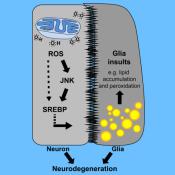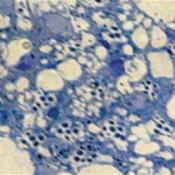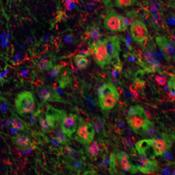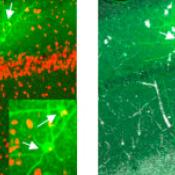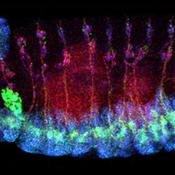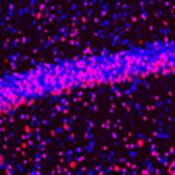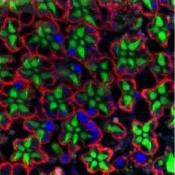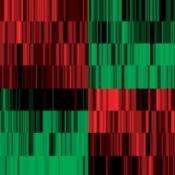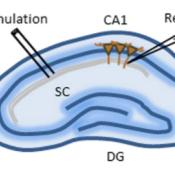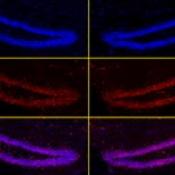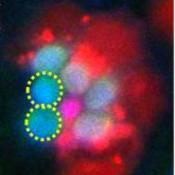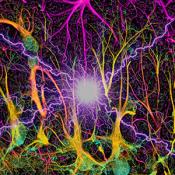Research Breakthroughs
Chronic low protein diet in female mice affects the activity and behavior of her adult male offsprings
1/19/17A team of researchers in the laboratory of Dr. Ignatia Van den Veyver found that adult male offspring of female mice that were fed chronic low-protein diet are sluggish, with increased body fat and anxiety-like behaviors even though they were on a normal diet since weaning. The results of this study were published in the online journal PLoS One.
Glial lipid droplets: A promising early biomarker and therapeutic target for certain neurodegenerative conditions
1/15/17A ground-breaking study conducted in the lab of Dr. Hugo J. Bellen has now identified a novel signaling mechanism that allows for accumulation of LDs in glial cells causing neurodegeneration. Specifically, they found that dysfunction of neuronal mitochondria (cellular energy generator) cause excess lipids to accumulate in the neighboring glial cells (support cells) in fruit flies and mice.
Inhibitory neuronal networks broaden with age and experience
1/9/17For the first time, in a study published in Nature Neuroscience, researchers in the laboratory of Dr. Benjamin Arenkiel have demonstrated how inhibitory circuits form and develop in live brains. They made a surprising discovery that inhibitory circuits expand as they mature. Prior to this study, scientists had very little understanding of how sensory maps of inhibitory circuits develop or mature.
Mutations in nardilysin or OGDHL causes neurodegeneration
12/29/16An international team led by Dr. Hugo J. Bellen, professor at Baylor College of Medicine and the Jan and Dan Duncan Neurological Research Institute (NRI) at Texas Children’s Hospital has identified a novel function for nardilysin, a mitochondrial protein, in the progressive degeneration of neurons. The study published in Neuron has utilized a relatively new multi-species genomics approach to provide a compelling genetic link between NRD1 and age-related neurodegeneration.
Iron toxicity is the likely cause of neurodegeneration in Fredreich's Ataxia
12/1/16A study published in the journal eLife by Dr. Hugo J. Bellen’s team shows that loss of frataxin protein may cause neurodegeneration by accumulation of excess iron in mice and humans. In this study, the Bellen team led by graduate student Kuchuan Chen found that deletion of FXN in mice is similarly deleterious and leads to neurobehavioral defects. This study shows for the first time that loss of Fxn can lead to an accumulation of iron within the neuronal cell bodies and extracellular spaces of vertebrate brains.
A possible new therapeutic target for Alzheimer’s and Parkinson’s diseases identified
10/31/16A study published in the journal eLife from the laboratory of Dr. Huda Zoghbi has found a key regulator of two important proteins that have been implicated in various neurodegenerative diseases including Parkinson’s and Alzheimer’s. Excessive accumulation of alpha-synuclein and tau is believed to be the underlying cause of neurodegenerative conditions. This discovery opens up a new therapeutic strategy that could potentially in the future benefit patients suffering from certain neurodegenerative conditions.
Deep brain stimulation can correct neural network malfunction in Rett syndrome mice
10/31/16A paper published this week in Neuron from Dr. Huda Y. Zoghbi’s laboratory shows that identical abnormalities in neural circuits might underlie similar features in two distinct genetic syndromes – Rett syndrome and MECP2 duplication syndrome. It was even more exciting that deep brain stimulation (DBS) reversed these circuit malfunctions in mouse models of Rett syndrome. The X-linked gene, MECP2, encodes methyl CpG-binding protein, a master regulator of several genes.
An international team discovers a novel Alzheimer’s disease risk gene among Icelanders
10/24/16Drs. Shinya Yamamoto, Joshua M. Shulman and Hugo J. Bellen are part of a multi-center collaborative study that identified a novel genetic risk factor for late-onset Alzheimer’s disease (LOAD). Postdoctoral fellow, Dr. David Li-Kroeger, and graduate student, Jose Salazar, also contributed to the study published in the journal PLoS Genetics this week. This research illustrates how experiments performed in simple model organisms can complement human genetic discoveries.
A kinase that restores memory and cognitive defects in a mouse model of Alzheimer's disease discovered
10/7/16In an exciting study published in the journal Neuron, Drs. Huda Zoghbi and Juan Botas have identified a kinase whose partial inhibition reduced aberrant tau aggregates and reversed memory deficits in a mouse model of neurodegeneration. In this study, researchers employed an innovative approach to identify novel genetic modifiers of tauopathy. They performed a stringent parallel cross-species screen of approximately 600 known kinases in a human cell line and fruit flies that overexpressed tau.
A novel role for the basal forebrain in regulating appetite
10/3/16A seminal study published in Nature from the laboratory of Dr. Benjamin Arenkiel, associate professor at Baylor College of Medicine and researcher at the Neurological Research Institute at Texas Children's Hospital, demonstrates that a subset of cholinergic neurons in the basal forebrain act as critical regulators to modulate food intake and control body weight.
Deep brain stimulation can correct neural malfunction in Rett and MeCP2 duplication syndrome mice
9/30/16A paper published this week in Neuron from Dr. Huda Y. Zoghbi’s laboratory shows that identical abnormalities in neural circuits might underlie similar features in two distinct genetic syndromes – Rett syndrome and MECP2 duplication syndrome. It was even more exciting that deep brain stimulation (DBS) reversed these circuit malfunctions in mouse models of Rett syndrome.
Loss of Frataxin causes neurodegeneration due to iron toxicity
8/23/16A recent study published in the journal eLife by Dr. Hugo J. Bellen’s team at Baylor College of Medicine and Neurological Research Institute at Texas Children’s Hospital has provided the first experimental evidence that loss of frataxin may cause neurodegeneration via iron toxicity.
NRI researchers develop a rat model of Rett Syndrome
7/14/16A team of researchers at the NRI led by Dr. Rodney Samaco characterized a novel genetic rat model of RTT that closely mimics many behavioral and molecular features of RTT patients. This study was published last week in the Human Molecular Genetics journal, with Dr. Surabi Veeraragavan. After confirming the rat model of RTT was missing the MeCP2 protein, the researchers set out to test the behavior of the animals, focusing on female rats.
Reducing MeCP2 levels reverses MeCP2 duplication syndrome
11/30/15In 2004 a team of researchers led by Dr. Huda Zoghbi, director of NRI and professor of molecular and human genetics at the Baylor College of Medicine, developed a mouse model for this duplication syndrome and hypothesized that excessive levels of MECP2 is the cause of the neurological symptoms observed in these patients. A year later the first individuals with duplication syndrome were diagnosed.
Deep brain stimulation restores learning and memory in Rett Syndrome mice
10/15/15In a recent study published in Nature, a team of researchers have demonstrated that DBS of a specific area of the brain can revert learning and memory deficits in a mouse model of Rett syndrome, a leading cause of intellectual disability in girls. Although DBS has shown some promise in many movement disorders and neuropsychiatric disorders in children, this is the first experimental demonstration of the effectiveness of DBS in treating a childhood cognitive disorder.
USP7: A deubiquinating enzyme implicated in neurodevelopmental disorders
9/16/15In a recent study published in Molecular Cell3, researchers have identified a novel role for Ubiquitin-specific peptidase 7 (USP7), a deubiquitinating enzyme, in PWS, Schaaf-Yang syndrome and a hitherto unidentified neurological disease. The authors initiated this study to identify interacting partners of MAGEL2-TRIM27 and were surprised to isolate a deubiquinating enzyme, USP7 as one of the interactors.
Insufficient energy production by mitochondria causes photoreceptor neurons to degenerate
7/16/15It is thought that mitochondrial defects result in elevated levels of oxidative stress, which is the primary cause of disease progression. However, contrary to this established paradigm, a recent study from Dr. Hugo Bellen’s team shows that mutations in some genes that affect mitochondrial ATP production cause neuronal degeneration independent of oxidative stress.
Neuronal hyperactivity accelerates the loss of neural stem cells
5/11/15An exciting study from the laboratories of Drs. Mirjana Maletic-Savatic and Juan Manuel Encinas, published in Cell Stem Cell, sheds light on how neuronal activity affects rNSC division and thereby, generation of new neurons in adults. They demonstrated that excessive neuronal activity results in the loss of rNSCs and thereby, affects short-term as well as long-term generation of new neurons in adult hippocampus.
Starvation and exercise stimulate autophagy via a novel lysosomal signaling mechanism
4/27/15In a recent study published in Nature Cell Biology, NRI researcher, Andrea Ballabio’s team has shown how starvation and exercise triggers a novel lysosomal calcium signaling cascade leading to transcriptional activation of the autophagic/lysosomal pathway. They found that under normal feeding conditions, mTORC1 kinase present on the lysosomal surface phosphorylates transcription factor B (TFEB), rendering it inactive. This form of TFEB can bind to 14-3-3 proteins that allows it to remain sequestered in the cytoplasm.
Chicken and mice models shed light on how to repair human neonatal brain injury
3/27/15An exciting study published in Neuron from the laboratory of Dr. Benjamin Deneen has identified a novel mechanism that regulates formation of OLs via Wnt signalosomes. More importantly, it has identified a promising Wnt regulator that is capable of stimulating remyelination in animal models of cerebral palsy and adult white matter injury.

